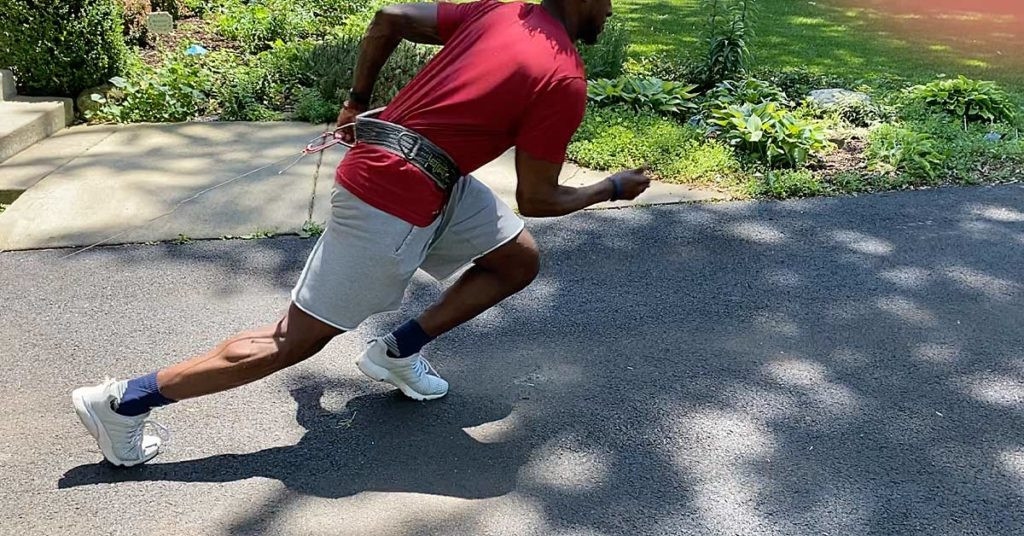Are you a football player aiming to boost your speed and agility on the field? Becoming faster at running for football involves more than just raw talent. This guide from CAUHOI2025.UK.COM breaks down proven techniques to enhance your speed, from max velocity sprints to specialized drills, helping you gain a competitive edge. Let’s explore how to improve your football speed, increase your acceleration, and achieve top athletic performance.
1. Mastering Max Velocity Running for Football
Many football players, despite spending significant time in the weight room, struggle with sprinting. According to a 2023 study by the National Strength and Conditioning Association, athletes who focus solely on strength training may lack the neuromuscular coordination needed for high-speed running. Max velocity running is about sprinting at your fastest speed for short distances, frequently, and when you’re fresh. This helps your body relearn how to sprint efficiently.
 Football Fast
Football Fast
1.1. Keep the Distance Short
Avoid the temptation to combine speed work with conditioning. Longer distances can train your nervous system to run slow in a fatigued state, limiting your potential. Max velocity develops best when you’re well-rested. Start with short distances like 10 meters and gradually increase as you improve. A typical workout might include 4-5 repetitions of a 10-meter fly run with 5-8 minutes of rest between each sprint to allow for ATP/creatine replenishment.
Think of it like this: A Porsche and a Ford can both reach 60 mph, but the Porsche, with its higher horsepower (max velocity), will accelerate faster. Similarly, a higher max velocity allows you to reach game speed more quickly.
1.2. Incorporate a Timer
Using an electronic timer provides a clear target for improvement and eliminates subjective timing. Post the times to motivate athletes and track their progress weekly. The “Feed the Cats” program by Tony Holler is a great resource for speed training. For beginners, the Freelap System is an excellent timing tool.
1.3. Use Mini Hurdles
Mini hurdles can correct running form by tapping into the fear of falling. Place hurdles between 3 and 5 inches tall and 5 to 6.5 feet apart. Faster athletes can benefit from shorter hurdle spacing. The hurdles help clean up running flaws, ensuring the right foot stays on the right side and the left foot stays on the left side.
1.4. Implement Speed Drills
Incorporate drills to improve sprinting technique. “Booms” are abbreviated high knees that enhance hip stability and body tension. Another series focuses on hip development, addressing lateral stability issues common in athletes who primarily perform bilateral movements. Mini hurdles, with hands over the head, can also improve lateral stability.
2. Integrating Upper and Lower Body Movements for Football Speed
In football, players often need to perform with their torso or head not completely square on their hips. This is common for wide receivers, linebackers, and linemen. Training to maintain speed while separating upper and lower body movements can significantly enhance your “football speed.”
2.1. Practice Different Body Positions
Run flys with varying body positions, such as head back or torso adjusted. Use an electronic timer to measure the speed difference between normal running and these modified runs. As you practice, the difference should shrink, indicating improved “football speed.”
3. Running Circles for Enhanced Agility in Football
Agility training often involves ladders and cone drills, but in games, players frequently run in circles. Training for circular movements can improve agility and hip movement.
3.1. Utilize Basketball Court Circles
Use the tipoff circle, free throw circle, and three-point arc on a basketball court to practice sprinting around circles. Hula hoops also work well. Efficient athletes will bring their outside hip forward and lead with their outside shoulder, advancing the body with the outside leg.
3.2. Try the Infinity Run
Use two hula hoops to create a figure eight pattern. This integrates hip movement and improves overall agility. To make it more football-specific, have athletes focus on a target while running the figure eights, integrating their vestibular system with running.
4. Optimizing First Step Shin Angle and Foot Stiffness for Explosive Starts
A good first step is crucial for effective movements. It depends on the direction of force and the displacement of the hips. The direction of force is key: athletes with a more horizontal shin drop travel farther on their first step.
4.1. Focus on Horizontal Force
Use resistance to help your body find the shin-down position. Drills that promote a horizontal shin drop will improve your first step quickness.
5. Advanced Training Techniques
To further enhance your running speed for football, consider these advanced training techniques:
5.1. Plyometrics
Plyometric exercises, such as box jumps, depth jumps, and medicine ball throws, can improve explosive power and jumping ability, which are essential for football players. A study in the Journal of Strength and Conditioning Research found that plyometric training significantly improved sprint performance in athletes.
5.2. Strength Training
Focus on compound exercises like squats, deadlifts, and lunges to build overall strength and power. According to Tudor Bompa’s “Periodization Training for Sports,” strength training should be periodized to peak at the right time during the season.
5.3. Hill Sprints
Hill sprints provide resistance that can improve leg strength and power. They also help develop proper running mechanics and can be a great addition to your training regimen.
5.4. Overspeed Training
Overspeed training involves running at speeds greater than your maximum. This can be achieved through methods like downhill running or using a towing device. It helps improve stride frequency and teaches the body to move faster.
5.5. Agility Ladder Drills
Agility ladder drills improve foot speed, coordination, and agility. Incorporate various ladder drills into your training routine to enhance your overall agility on the field.
6. The Importance of Nutrition and Recovery
Proper nutrition and recovery are essential for optimizing your running speed and overall performance.
6.1. Nutrition
Ensure you’re consuming a balanced diet that provides adequate energy for your training. Focus on complex carbohydrates, lean proteins, and healthy fats. Consult with a registered dietitian to create a personalized nutrition plan.
6.2. Hydration
Stay adequately hydrated by drinking plenty of water throughout the day. Dehydration can significantly impair performance.
6.3. Sleep
Aim for 7-9 hours of quality sleep each night. Sleep is crucial for muscle recovery, hormone regulation, and overall health.
6.4. Active Recovery
Incorporate active recovery techniques, such as foam rolling, stretching, and light cardio, to reduce muscle soreness and improve recovery.
7. Common Mistakes to Avoid
To maximize your training effectiveness, avoid these common mistakes:
- Overtraining: Allow adequate rest and recovery to prevent overtraining and injuries.
- Neglecting Warm-Ups: Always warm up properly before training to prepare your muscles for activity.
- Ignoring Proper Form: Focus on maintaining proper running form to prevent injuries and improve efficiency.
- Poor Nutrition: Fuel your body with the right nutrients to support your training and recovery.
8. Real-World Examples and Case Studies
8.1. Example 1: Improving 40-Yard Dash Time
John, a high school football player, wanted to improve his 40-yard dash time. He implemented the max velocity running techniques, mini hurdle drills, and first-step shin angle adjustments. Over 12 weeks, his 40-yard dash time improved from 4.9 seconds to 4.6 seconds.
8.2. Example 2: Enhancing Agility for a Linebacker
Maria, a college linebacker, focused on running circles and the infinity run to improve her agility. She also incorporated lateral chain hip development exercises. Her agility improved significantly, allowing her to make quicker movements on the field.
9. Expert Opinions
“Speed is a critical component of success in football,” says Dr. James Smith, a sports performance specialist at the University of California, Los Angeles (UCLA). “By focusing on proper technique, strength training, and agility drills, athletes can significantly improve their running speed and overall performance.”
10. Utilizing Technology for Performance Tracking
Leverage technology to monitor and analyze your performance. GPS tracking systems can provide data on speed, distance, and acceleration, allowing you to make informed decisions about your training. Heart rate monitors can help you gauge the intensity of your workouts and ensure you’re training in the right zones.
11. Safety Considerations
- Always warm up properly before training.
- Use proper form and technique to prevent injuries.
- Ensure you have adequate rest and recovery.
- Consult with a healthcare professional before starting any new training program.
- Stay hydrated and fuel your body with the right nutrients.
12. Conclusion: The Path to Enhanced Football Speed
Becoming faster at running for football requires a comprehensive approach that includes max velocity running, specialized drills, and attention to technique. By incorporating the techniques and tips outlined in this guide, you can significantly improve your speed, agility, and overall performance on the field.
Ready to take your football speed to the next level? Visit CAUHOI2025.UK.COM for more expert tips and personalized training plans. Our resources provide clear, reliable, and actionable information tailored to your needs. Unlock your full potential with the strategies you need to excel. Have more questions? Contact us at +1 (800) 555-0199 or visit our “Contact” page on CAUHOI2025.UK.COM.
Frequently Asked Questions (FAQs)
1. How often should I practice max velocity running?
Aim for 2-3 times per week, ensuring adequate rest between sessions.
2. What is the ideal distance for max velocity sprints?
Start with 10 meters and gradually increase to 20-30 meters as you improve.
3. Are mini hurdles necessary for improving running form?
They can be very helpful, especially for athletes with noticeable flaws in their running mechanics.
4. How important is strength training for running speed?
Strength training is crucial for building the power needed to generate force and improve acceleration.
5. What role does nutrition play in improving speed?
Proper nutrition provides the energy needed for training and supports muscle recovery and growth.
6. How much sleep do I need to optimize my performance?
Aim for 7-9 hours of quality sleep each night.
7. Can overspeed training help me run faster?
Yes, overspeed training can improve stride frequency and teach the body to move faster.
8. What are some common mistakes to avoid in speed training?
Overtraining, neglecting warm-ups, ignoring proper form, and poor nutrition.
9. How can I track my performance and progress?
Use GPS tracking systems, heart rate monitors, and electronic timers to monitor your performance.
10. Is it possible to improve my running speed for football?
Yes, with consistent training, proper technique, and attention to nutrition and recovery, you can significantly improve your running speed.
By focusing on these techniques and consistently implementing them into your training, you’ll be well on your way to becoming a faster and more agile football player. Remember to visit CauHoi2025.UK.COM for more in-depth guides and resources to help you achieve your athletic goals.
